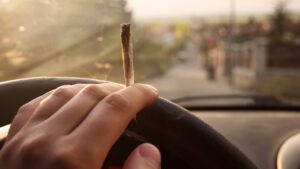California Vehicle Code § 23152(f) VC makes it a crime to drive under the influence of drugs. This offense is usually a misdemeanor. But it can be a felony if someone is injured, or if you have at least one prior felony DUI or at least three prior misdemeanor DUI convictions.
|
23152(f) VC crime |
Fine |
Ignition interlock device period |
DUI School |
|
| 1st offense (misdemeanor) | Up to 6 months in county jail | $390-1000 | 6 months | 3 or 9 months |
| 2nd offense (misdemeanor) | 96 hours to 1 year in county jail | $390-1000 | 1 year | 18 or 30 months (SB 38) |
| 3rd offense (misdemeanor) | 120 days to 1 year in county jail | $390-1000 | 2 years | 30 months |
| 4th offense (felony) | 16 months, 2 years or 3 years in state prison | $390-1000 | up to 5 years of driver’s license suspension | 18 or 30 months |
| DUI with injury (as a misdemeanor) | 5 days to 1 year in county jail | $390-5000 plus restitution | 6 months | 3, 18 or 30 months |
| 1st offense DUI with injury (as a felony) | 16 months to 16 years in state prison | $1015-5000 plus restitution | 1 year | 18 or 30 months |
1. What drugs are covered by Vehicle Code 23152(f)?
Any drug that can impair your ability to drive is covered by Vehicle Code 23152(f).
This includes illegal drugs and their metabolites such as:
- heroin,
- ecstasy,
- methamphetamine,
- cocaine, and
- LSD.
It also includes prescription drugs such as:
It even includes over-the-counter drugs such as:
- cold medicine,
- allergy medicine like antihistamines, and
- sleeping pills.
The statute also covers DUI of marijuana.
All that matters is that it impairs your ability to drive safely.1 It is not a defense that you were entitled to use that particular drug or needed it for a medical condition.2
2. Is there a legal limit for drugs?
No. California Vehicle Code 23152(f) prohibits driving a motor vehicle with any amount of drugs in your blood or urine that impairs your ability to drive safely. Unlike the .08% blood alcohol concentration (BAC) limit for alcohol, there is no specified numerical “per se” limit for drug concentrations.
Therefore, it is legal to drive with drugs in your system as long as they do not impair your driving. During traffic stops, the police judge your impairment by observing your behavior and conducting field sobriety tests (FSTs).
California is different from some states like Illinois and Ohio which prohibit driving with certain levels of drugs in your blood, even if you are being safe and do not appear high.3
3. How do police build a DUID case?
Without a standard legal limit, police have a great deal of discretion as to when they make arrests for drugged driving. Law enforcement officers can arrest you if they suspect you of being under the influence of drugs.
Typically, a drug recognition expert (DRE) is brought in to conduct an investigation. Drug recognition experts are police officers with special training in the signs of drug impairment. Their investigation involves:
- field sobriety tests (FSTs),
- taking your vital signs,
- a roadside breathalyzer test (PAS test) – a normal result may indicate you have ingested drugs rather than alcohol because breath tests detect only blood alcohol concentration (BAC) and not drug use
- noting objective symptoms of intoxication (such as glazed eyes), and
- interviewing you.
Law enforcement will also require you to provide a urine test or blood test (chemical test) following a DUI arrest. (Saliva tests cannot detect drug use.)

Drugged driving is a different offense from driving under the combined influence of alcohol and drugs (covered under 23152(g) VC).
4. What does it mean to “drive a vehicle”?
Vehicle Code 23152(f) can only be violated if you were driving a vehicle on a public roadway (not private property).
You drive a vehicle by intentionally using physical control to make it move.4 The engine does not need to be on, though the vehicle still has to move.5 Police can use circumstantial evidence if they did not see it move.6
A vehicle is anything that moves on a highway unless it is propelled by a person.7 Examples of a vehicle include:
- cars,
- trucks,
- motorcycles,
- buses,
- E-scooters or E-bikes,
- motorized wheelchairs, and
- horse-drawn carriages.
Vehicles do not include:
- bicycles,
- trains or trolleys,
- skateboards, and
- manual wheelchairs.
5. What defenses can I assert?
The most common defenses that we rely on to get DUID charges reduced or dismissed are:
- there was no reasonable suspicion for the DUI traffic stop or probable cause for the DUI arrest,
- you were not impaired at the time of the arrest,
- there were innocent explanations for signs of drug impairment or traffic violations, and/or
- you ingested the drugs long before driving, and they had no effect on you even though the blood test detected them in your system.
Here at Shouse Law Group, we have experience handling thousands of DUI cases. To give us an edge over the prosecutors, we may employ such tactics such as:
- hiring a toxicologist expert witness (usually a doctor) to show that you were not under the influence of drugs or in any way impaired by drugs;
- hiring an accident reconstruction expert witness to show that any collision that occurred was not caused by you or from being impaired;
- hiring a medical expert witness to study your medical records and show that any inebriated-like behavior you exhibited was not due to drugs but instead a medical condition or an episode, such as a seizure;
- challenging the validity of your blood test results and pointing out where the police’s “chain of custody” of your blood samples may have been compromised; or
- poring over the state’s evidence in search of all the places where the police made a mistake, such as giving you inaccurate field sobriety test instructions or pulling you over without reasonable suspicion.
Ultimately, the D.A. has the very high burden to prove beyond a reasonable doubt that both:
- You were driving, and
- You were under the influence of drugs while driving.9
We know from experience all the best ways to poke holes in the state’s case and show reasonable doubt, which may persuade the prosecutors to dismiss all DUID charges before trial.
6. What are the penalties for a conviction?
California Vehicle Code 23152(f) makes DUI with drugs a misdemeanor in most cases. DUID becomes felony when you have at least one prior felony DUI conviction or at least three prior misdemeanor DUI convictions.
A first-time DUI can carry:
- up to 6 months in county jail,
- 3 to 5 years of probation,
- a driver’s license suspension by the DMV (even if your BAC was legal),
- DUI school (drug and alcohol education and awareness classes),
- possibly community service, and
- fines of $390 to $1,000 (plus fees and a penalty assessment that can make the total very high).
Note that most courts will impose little or no actual jail time for the first offense with no aggravating circumstances. As long as you complete all the terms of the probationary sentence, the judge usually imposes no jail.
Meanwhile, a fourth-time offense is a wobbler, which means you could be convicted of it as either a felony or a misdemeanor.
Also note that DUI arrests trigger two cases: The criminal case and the DMV administrative case. If the blood results come back with a legal blood alcohol content, the DMV will not impose an administrative suspension of your driver’s license. Though if you ultimately get convicted of DUI with drugs, then the DMV will suspend your license.10

People arrested for violating VC 23152(f) must submit to a blood test.
Additional resources
For more information, refer to the following:
- Drugged Driving DrugFacts – Overview by the National Institute on Drug Abuse.
- Drugged Driving—What You Should Know – FAQs by the Drug Enforcement Administration (DEA).
- Impaired Driving Isn’t Limited to Just Alcohol – Information and statistics compiled by Mothers Against Drunk Driving (MADD).
- Drug-Impaired Driving – Drug facts and legal summary by the National Highway Traffic Safety Administration (NHTSA).
- Narcotics Anonymous – 12-step program to overcome drug addiction.
Legal References:
- California Criminal Jury Instructions CALCRIM 2110 (“A drug is a substance or combination of substances, other than alcohol, that could so affect the nervous system, brain, or muscles of a person that it would appreciably impair his or her ability to drive as an ordinarily cautious person, in full possession of his or her faculties and using reasonable care, would drive under similar circumstances”). Drugged driving arrests have even been made in California for driving under the influence of coffee (A.J. Willingham, “A DUI for caffeine? DA makes decision in strange case,” CNN (December 29. 2016)).
- California Vehicle Code 23630. See also People v. Gallardo (1994) 22 Cal.App.4th 489; People v. Andersen (1994) 26 Cal.App.4th 1241.
- See National Highway Traffic Safety Administration, “Drug-Impaired Driving: Understanding the Problem and Ways to Reduce It—A Report to Congress,” (“[A]t the current time, specific drug concentration levels cannot be reliably equated with effects on driver performance”). VC 23152(f) (“It is unlawful for a person who is under the influence of any drug to drive a vehicle.”). See, for example, Illinois’ per se DUID law at 625 ILCS 5/11-501 and Ohio’s per se DUID law at ORC 4511.19.
- California Criminal Jury Instructions 2241. See also Mercer v. Department of Motor Vehicles, (Cal. 1991) 809 P.2d 404.
- People v. Hernandez, (Cal. App. 1990) 219 Cal.App.3d 1177.
- People v. Wilson, (Cal. App. 1985) 176 Cal.App.3d Supp. 1.
- California Vehicle Code section 670.
- People v. Wilson, Supra.
- See also: People v. Adams (1976) 59 Cal.App.3d 559; People v. Williams (2002) 28 Cal.4th 408; People v. Esayian (2003) 112 Cal.App.4th 1031; People v. Lopez (Cal. App. 3d Dist., 2020), 260 Cal. Rptr. 3d 18.
- See also People v. Weathington (1991) 231 Cal.App.3d 69; People v. Calderon (1994) 9 Cal.4th 69; People v. Cline (1998) 60 Cal.App.4th 1327; People v. Hall (1998) 67 Cal.App.4th 128; People v. Garcia (1989) 214 Cal.App.3d Supp. 1.
